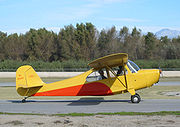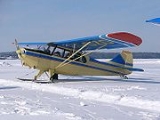
Aeronca Champion
Encyclopedia
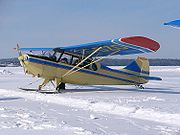
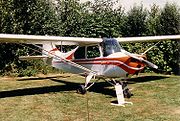
Conventional landing gear
thumb|The [[Piper PA-18|Piper Super Cub]] is a popular taildragger aircraft.thumb|right|A [[Cessna 150]] converted to taildragger configuration by installation of an after-market modification kit....
airplane
Fixed-wing aircraft
A fixed-wing aircraft is an aircraft capable of flight using wings that generate lift due to the vehicle's forward airspeed. Fixed-wing aircraft are distinct from rotary-wing aircraft in which wings rotate about a fixed mast and ornithopters in which lift is generated by flapping wings.A powered...
. Designed for flight training
Flight training
Flight training is a course of study used when learning to pilot an aircraft. The overall purpose of primary and intermediate flight training is the acquisition and honing of basic airmanship skills....
and personal use, it entered production in the United States in 1945.
Design and development
Like the Piper CubPiper J-3
The Piper J-3 Cub is a small, simple, light aircraft that was built between 1937 and 1947 by Piper Aircraft. With tandem seating, it was intended for flight training but became one of the most popular and best-known light aircraft of all time...
with which it competed, the Champ features tandem seating. While the J-3 model of the Cub is soloed from the rear seat, the Champ can be soloed from the front, giving improved forward visibility on the ground and during takeoffs, landings, and climbs. The Champ has a wider cabin than the Cub and offers better visibility.
As with many light aircraft of the time, the Champ’s fuselage
Fuselage
The fuselage is an aircraft's main body section that holds crew and passengers or cargo. In single-engine aircraft it will usually contain an engine, although in some amphibious aircraft the single engine is mounted on a pylon attached to the fuselage which in turn is used as a floating hull...
and tail surfaces are constructed of welded metal tubing. The outer shape of the fuselage is created by a combination of wooden former
Former
thumb|right|150px|Interior of an F-16B with the engine removed showing frames or formers.A former is a structural member of an aircraft fuselage, of which a typical fuselage has a series from the nose to the empennage, typically perpendicular to the longitudinal axis of the aircraft...
s and longeron
Longeron
In aircraft construction, a longeron or stringer or stiffener is a thin strip of wood, metal or carbon fiber, to which the skin of the aircraft is fastened. In the fuselage, longerons are attached to formers and run the longitudinal direction of the aircraft...
s, covered with fabric. The cross-section of the metal fuselage truss is triangular, a design feature which can be traced all the way back to the earliest Aeronca C-2
Aeronca C-2
-See also:-External links:*...
design of the late 1920s.
The strut-braced wings of the Champ are, like the fuselage and tail surfaces, fabric covered, utilizing aluminum ribs
Rib (aircraft)
In an aircraft, ribs are forming elements of the structure of a wing, especially in traditional construction.By analogy with the anatomical definition of "rib", the ribs attach to the main spar, and by being repeated at frequent intervals, form a skeletal shape for the wing...
. Most Champs were built with wooden spars. American Champion has been using aluminum spars in the aircraft it has produced and has, as well, made the aluminum-spar wings available for retrofit installation on older aircraft.
The landing gear of most Champs is in a conventional arrangement, though a model with tricycle gear was produced, and a model with reversed tricycle gear was tried. Conventional-gear Champs feature a steerable tailwheel and most have steel tube main gear which use an oleo strut for shock absorption; one variant utilized spring steel main gear, and American Champion is using aluminum gear legs in its production model of the Champ. The tricycle-gear Champs use the steel tube and oleo strut main gear, mating these with an oleo strut nose gear.
Models 7AC, 7CCM, 7DC, and 7EC were approved as seaplane
Seaplane
A seaplane is a fixed-wing aircraft capable of taking off and landing on water. Seaplanes that can also take off and land on airfields are a subclass called amphibian aircraft...
s, with the addition of floats and vertical stabilizer fins; the seaplane versions were designated the S7AC, S7CCM, S7DC, and S7EC, respectively. Float and supplemental fin installations are also approved for models 7ECA, 7GC, 7GCB, 7GCBC, and properly modified 7HC's.
Production history
Built by Aeronca Aircraft CorporationAeronca Aircraft
Aeronca, contracted from Aeronautical Corporation of America, located in Middletown, Ohio, is a US manufacturer of engine components and airframe structures for commercial aviation and the defense industry...
, the Champ first flew in 1944, having been designed in tandem with the 11AC Chief—the Champ with tandem seating and joystick controls, and the Chief with side-by-side seating and yoke controls. The intention was to simplify production and control costs by building a pair of aircraft with a significant number of parts in common; in fact, the two designs share between 70% and 80% of their parts. The tail surfaces, wings, landing gear, and firewall forward—engine, most accessories, and cowling, are common to both airplanes.
Selling for $2,095, the Champ outsold the Chief by an 8 to 1 margin. Engine upgrades in 1948 and 1949 resulted in the Models 7DC and 7EC. Between 1945 and 1950, Aeronca was producing 50 light aircraft per day and by the time production ended in 1951, the company had sold more than 10,000 Champions.
Aeronca ceased all production of light aircraft in 1951, and the Champ design was sold in 1954 to Champion Aircraft.
Champion Aircraft was acquired in 1970 by Bellanca Aircraft
AviaBellanca Aircraft
AviaBellanca Aircraft Corporation is an American aircraft design and manufacturing company. Prior to 1983 it was known as the Bellanca Aircraft Company...
which continued production of their Champ-derived Citabria and Decathlon designs. In 1971, Bellanca introduced the 7ACA version of the Champ as a more basic complement to their other designs. Only a handful of 7ACA's were built between 1971 and 1972. Bellanca ceased all production in the early 1980s.
American Champion Aircraft Corporation
American Champion
American Champion Aircraft Corporation, located in Rochester, Wisconsin, is a manufacturer of general aviation aircraft. Founded in 1988 on the acquisition of the Champ, Citabria, Scout, and Decathlon, it has been producing replacement parts for these aircraft since that time; it has as well been...
acquired the Champ and related designs in 1989. In 2001, they were rumored to be considering a reintroduction of the Champ design as a 7EC powered by a Jabiru Aircraft
Jabiru Aircraft
Jabiru Aircraft Pty Ltd is an Australian aircraft manufacturer that produces a range of kit- and ready-built civil light aircraft in Bundaberg, Queensland. The company also designs and manufactures a range of light aircraft engines...
engine. While a test version was flown, this combination was not put into production. With the creation of the Light Sport
Light-sport Aircraft
A Light-sport aircraft, also known as light sport aircraft or LSA, is a small aircraft that is simple to fly and which meets certain regulations set by a National aviation authority restricting weight and performance...
category of aircraft in the United States by the FAA
Federal Aviation Administration
The Federal Aviation Administration is the national aviation authority of the United States. An agency of the United States Department of Transportation, it has authority to regulate and oversee all aspects of civil aviation in the U.S...
, American Champion in late 2007 began producing a revised version of the 7EC.
Variants
Various versions of the Champ have been tested and produced since 1944. The derivative Citabria designs — models 7ECA, 7GCAA, 7GCBC, and 7KCAB — are discussed in a separate article, as is the twin-engined 402 LancerChampion Lancer
The Champion 402 Lancer was an attempt to produce an inexpensive twin engine trainer by using two Continental O-200 engines on the wings of a tricycle gear Champion 7FC. The aircraft has fixed landing gear, and fixed pitched propellers....
.)

7AC Champion
Introduced in 1945, the 7AC was the first version of the design and used the Continental A-65-8Continental O-170
|-See also:-References:*Christy, Joe: Engines for Homebuilt Aircraft & Ultralights, pages 43-52. TAB Books, 1983. ISBN 0830623477...
engine of 65 hp. It featured a conventional landing gear configuration, with shock absorption in the main gear provided by oleo struts, 7200 built.

7BCM, L-16A
Aeronca began building the 7BCM in 1947. This version upgraded the engine to a Continental C85Continental O-190
|-See also:-References:* Gunston, Bill. World Encyclopedia of Aero Engines. Patrick Stephens: Wellingborough.* Erickson, Jack. ...
, and featured a "no-bounce" version of the main landing gear. All of the 7BCM production went to the military as model L-16A
Aeronca L-16
|-See also:-References:* Eden, Paul and Moeng, Soph, eds. The Complete Encyclopedia of World Aircraft. London: Amber Books Ltd., 2002. ISBN 0-7607-3432-1....
. These served with the United States Air Force
United States Air Force
The United States Air Force is the aerial warfare service branch of the United States Armed Forces and one of the American uniformed services. Initially part of the United States Army, the USAF was formed as a separate branch of the military on September 18, 1947 under the National Security Act of...
, Army
United States Army
The United States Army is the main branch of the United States Armed Forces responsible for land-based military operations. It is the largest and oldest established branch of the U.S. military, and is one of seven U.S. uniformed services...
, and National Guard
United States National Guard
The National Guard of the United States is a reserve military force composed of state National Guard militia members or units under federally recognized active or inactive armed force service for the United States. Militia members are citizen soldiers, meaning they work part time for the National...
. In 1956, many L-16s were transferred to the United States' Civil Air Patrol
Civil Air Patrol
Civil Air Patrol is a Congressionally chartered, federally supported, non-profit corporation that serves as the official civilian auxiliary of the United States Air Force . CAP is a volunteer organization with an aviation-minded membership that includes people from all backgrounds, lifestyles, and...
. Many L-16As ultimately made their way back into civilian use as 7BCMs.
7CCM, L-16B
Militarized version – Army L-16BAeronca L-16
|-See also:-References:* Eden, Paul and Moeng, Soph, eds. The Complete Encyclopedia of World Aircraft. London: Amber Books Ltd., 2002. ISBN 0-7607-3432-1....
An improved version of the L-16, the L-16B/7CCM featured a 90 hp Continental C90-8 engine, an enlarged vertical tail, hydraulic brakes, and a gross weight increased to 1300 lb (589.7 kg). Unlike the L-16A not all production went to the USAF. Due to an early cancellation of the production contract some aircraft went directly to the civilian market as 7CCM Champions. The military L-16B featured hydraulic brakes and the "no bounce" landing gear while civilian 7CCM models retained the hydraulic brakes but were fitted with the standard Aeronca oleo landing gear. The L-16A and B featured an enlarged "greenhouse" canopy glazing whereas the civilian 7CCM had the original type windows and headliner. Many USAF and Civil Air Patrol L-16Bs returned to the civil market as 7CCMs after their military service.
7DC
Continental C85 engine. 85 hp similar to the 7AC except the vertical stabilizer is extended forward to accommodate the increase torque from the increased horse power and the cowling is increased because of the larger engine.7EC Traveler
1950 brought the introduction of the Aeronca 7EC, which featured the Continental C90Continental O-200
The Continental C90 and O-200 are a family of air-cooled, horizontally opposed, four-cylinder, direct-drive aircraft engines of 201 in³ displacement, producing between 90 and 100 horsepower ....
engine of 90 hp. Based on the 7CCM with an increased gross weight, 773 built.
The last Champ produced at Aeronca was a 7EC, and when Champion reintroduced the Champ in 1955, it was with their version of the 7EC, very little changed from Aeronca's. Champion's version did replace the mechanical brakes with hydraulic. It was also produced with luxury details as the Champion Deluxe.
In late 2007, American Champion introduced a revised version of the 7EC, featuring the Continental O-200-A
Continental O-200
The Continental C90 and O-200 are a family of air-cooled, horizontally opposed, four-cylinder, direct-drive aircraft engines of 201 in³ displacement, producing between 90 and 100 horsepower ....
engine of 100 hp. Differing in a number of ways from earlier 7ECs, this new version in particular replaces the wood-spar wings of the earlier versions with a metal-spar wing, and it uses aluminum gear legs. To fit within the Light Sport requirements, the maximum weight is reduced to 1,320 pounds (599 kilograms).
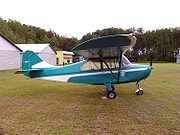
7FC Tri-Traveler
In 1957, Champion brought out the 7FC, a design sharing many parts, including the engine, with their version of the 7EC. The most significant difference in the 7FC was its tricycle landing gear arrangement. The main gear and the nose gear utilized oleo struts, 472 built.7GCA Sky Trac
Agricultural variant of the 7GC with a 150 hp Lycoming O-320-A2B engine, 396 built.7ACA
In 1971 Bellanca introduced the 7ACA, a modernized version of the design which made it a variant of the Citabria line. The 7ACA is powered by the two-cylinder Franklin 2A engine of 60 hp, a change which required a cowling redesign. The oleo-strut main gear are replaced by steel legs like those used on the later Citabria models, and the rear side windows are squared-off versions, again matching the Citabrias.Specifications (7AC)
